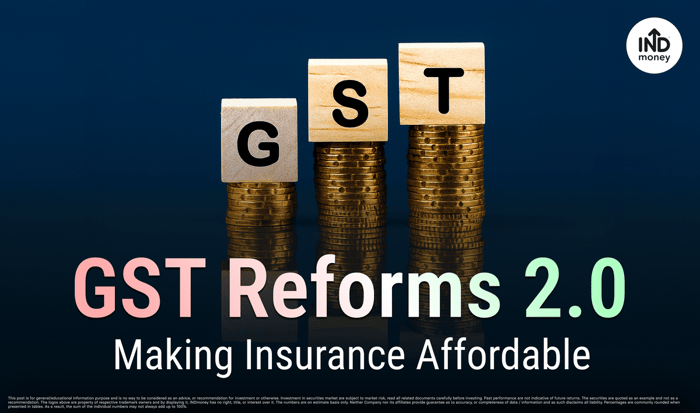
- Insurance Made Affordable: GST Slashed to Zero
- India’s Insurance Sector: Growth with Room to Expand
- Industry Response
- What This Means for the Common Man
- Conclusion
India is the fifth-largest life insurance market globally, according to CII, and the sector has just received a major boost with the announcement of GST Reforms 2.0. These reforms are expected to strengthen insurers’ business prospects and, more importantly, ease the financial burden on policyholders.
Taking effect from 22nd September 2025, the changes will bring much-needed relief to households and businesses. Beyond the tax cuts, India’s insurance sector has been steadily growing, setting the stage for these reforms to make a meaningful impact.
Let’s dive into the rate changes, how the industry is responding, and what it means for the common man.
Insurance Made Affordable: GST Slashed to Zero
Under the revised framework, GST rates on insurance products have been reduced:
| Insurance Product | Old GST Rate | New GST Rate |
| Individual Health Insurance | 18% | 0% |
| Individual Life Insurance | 18% | 0% |
With GST on all individual life insurance products, whether term plans, Unit Linked Insurance Plans (ULIPs), or endowment policies now reduced to nil, insurance has become more affordable for policyholders while boosting demand and long-term industry growth.
India’s Insurance Sector: Growth with Room to Expand
India’s insurance sector is on a steady growth path, with key metrics like premium collections, penetration, and density reflecting consistent progress.
- Premium collections by Public Sector General Insurance Companies (PSGICs) have risen notably from around ₹80,000 crore in 2019 to nearly ₹1.06 lakh crore in 2025.
- The overall general insurance industry reported premium collections of ₹3.07 lakh crore in FY 2024–25, reflecting ongoing momentum and recovery across both public and private insurers.
- Yet, despite this progress, the sector’s penetration remains modest. General insurance in India accounts for just 1% of GDP, below the global average of 4.2% in 2023.
- However, there are positive signs too: insurance density (the average premium per person) has grown from about ₹750 in 2019 to over ₹2,000 in 2023, showing rising awareness and adoption among consumers.
With reforms like GST 2.0, India is well-positioned to deepen penetration, expand coverage, and strengthen financial resilience.
Industry Response
Executives across the industry view the reforms as a long-awaited step that aligns with the government’s broader vision of “Insurance for All.”
HDFC Life
- HDFC Life has officially welcomed the GST cut on individual life insurance products, calling it a positive reform that will lower costs, make policies more attractive.
- The insurer confirmed it will shift to the new GST regime from September 22, 2025, and expects the GST cut to have minimal impact of less than 0.5% on the value of its existing policies, while encouraging more families to secure protection.
SBI Life
- SBI Life applauded the GST reduction on individual life insurance and reinsurance, calling it a vital step toward affordability. With the new GST regime starting September 22, 2025, the insurer is preparing for a smooth transition.
- The insurer expects the cut to have minimal impact of less than 0.2% on the value of its current policies, while driving higher demand, expanding reach, and supporting future growth.
What This Means for the Common Man
For policyholders and potential buyers, the GST cut translates into multiple tangible benefits:
- Lower Premiums: Reduced tax rates bring down the cost of life and health insurance, making policies more affordable.
- Increased Coverage: With premiums becoming more affordable, individuals and families can now opt for higher coverage without straining their budgets.
- Wider Penetration: The reforms are expected to bring more people into the insurance fold, especially across semi-urban and rural areas, while also encouraging first-time buyers.
- Enhanced Financial Security: Making insurance more accessible, the reforms promote long-term financial stability and protection against life and health risks.
Conclusion
The GST reforms mark a major shift in India’s insurance landscape, making policies more affordable, building a stronger safety net for the common man, and unlocking new growth opportunities for insurers. A true win-win for both insurers and policyholders, the move boosts accessibility, drives demand, and strengthens the industry’s long-term growth path, advancing the vision of “Insurance for All by 2047” and moving India closer to universal financial protection.
Disclaimer
Investments in the securities market are subject to market risks, read all the related documents carefully before investing. The securities are quoted as an example and not as a recommendation.This is nowhere to be considered as an advice, recommendation or solicitation of offer to buy or sell or subscribe for securities. INDStocks SIP / Mini Save is a SIP feature that enables Customer(s) to save a fixed amount on a daily basis to invest in Indian Stock. INDstocks Private Limited (formerly known as INDmoney Private Limited) 616, Level 6, Suncity Success Tower, Sector 65, Gurugram, 122005, SEBI Stock Broking Registration No: INZ000305337, Trading and Clearing Member of NSE (90267, M70042) and BSE, BSE StarMF (6779), SEBI Depository Participant Reg. No. IN-DP-690-2022, Depository Participant ID: CDSL 12095500, Research Analyst Registration No. INH000018948 BSE RA Enlistment No. 6428. Refer https://indstocks.com/pricing?type=indian-stocks; https://www.indstocks.com/page/indian-stocks-sip-terms-and-condition for further details.